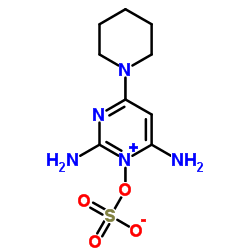Minoxidil sulphate

Minoxidil sulphate structure
|
Common Name | Minoxidil sulphate | ||
|---|---|---|---|---|
| CAS Number | 83701-22-8 | Molecular Weight | 289.311 | |
| Density | N/A | Boiling Point | 732ºC at 760 mmHg | |
| Molecular Formula | C9H15N5O4S | Melting Point | 175-180°C | |
| MSDS | Chinese USA | Flash Point | 396.5ºC | |
| Symbol |

GHS07 |
Signal Word | Warning | |
|
Molecular biology of the human cytosolic sulfotransferase gene superfamily implicated in the bioactivation of minoxidil and cholesterol in skin.
Exp. Dermatol. 8(4) , 328-9, (1999) Cytosolic sulfotransferases (ST) catalyze the sulfation of various phenolic agents, catecholamines, thyroid hormones, steroids, drugs, and procarcinogens, usually resulting in the inactivation and subsequent excretion of the compound. My laboratory's efforts ... |
|
|
Iontophoresis-targeted, follicular delivery of minoxidil sulfate for the treatment of alopecia.
J. Pharm. Sci. 102(5) , 1488-94, (2013) Although minoxidil (MX) is a drug known to stimulate hair growth, the treatment of androgenic alopecia could be improved by delivery strategies that would favor drug accumulation into the hair follicles. This work investigated in vitro the potential of iontop... |
|
|
Sulfation of minoxidil by multiple human cytosolic sulfotransferases.
Chem. Biol. Interact. 109(1-3) , 53-67, (1998) Minoxidil is an antihypertensive agent and hair growth promoter that is metabolized by sulfation to the active compound, minoxidil sulfate. Thermostable phenol sulfotransferase (TS PST or P-PST) was initially thought to catalyze the reaction, and the enzyme w... |
|
|
Different effects of KCaand KATPagonists on brain tumor permeability between syngeneic and allogeneic rat models
Brain Res. 1227 , 198-206, (2008) The blood–brain tumor barrier (BTB) significantly limits delivery of effective concentrations of chemotherapeutic drugs to brain tumors. Previous studies suggest that BTB permeability may be modulated via alteration in the activity of potassium channels. In t... |
|
|
Adenosine 5'-triphosphate-sensitive potassium channel activator induces the up-regulation of caveolin-1 expression in a rat brain tumor model.
Cell. Mol. Neurobiol. 31(4) , 629-34, (2011) This study was performed to determine whether minoxidil sulfate (MS), a selective Adenosine 5'-triphosphate-sensitive potassium channel (K (ATP) channel) activator, has an effect on the expression of caveolin-1 in the rat's brain tumor tissue. Using a rat bra... |
|
|
Vascular pharmacology of ATP-sensitive K+ channels: interactions between glyburide and K+ channel openers.
J. Vasc. Res. 30(1) , 2-12, (1993) This study in isolated rabbit superior artery (RMA) investigated the interactions between glyburide, a known blocker of vascular ATP-sensitive K+ channels (KATP), and several chemically diverse potassium channel openers (PCOs): minoxidil sulfate (MNXS; 5 micr... |
|
|
Synergistic effects of glyburide and U-37883A, two structurally different vascular ATP-sensitive potassium channel antagonists.
J. Pharmacol. Exp. Ther. 267(1) , 25-30, (1993) Glyburide, a sulfonylurea, and U-37883A, a guanidine (4-Morpholinecarboximidine-N-1-Adamantyl-N' cyclohexylhydrochloride), have been previously characterized as antagonists of the vascular ATP-sensitive K+ channels (KATP). In this report, the in vitro interac... |
|
|
Differential inhibition by tedisamil (KC 8857) and glibenclamide of the responses to cromakalim and minoxidil sulphate in rat isolated aorta.
Naunyn Schmiedebergs Arch. Pharmacol. 345(2) , 244-50, (1992) The effects of the K+ channel blockers tedisamil and glibenclamide on cromakalim- and minoxidil sulphate-induced 42K+ and 86Rb+ efflux and vasorelaxation in rat aorta, were investigated. In aortic strips preloaded with 42K+ or 86Rb+, cromakalim (1 mumol/l) in... |
|
|
Pharmacology and structure-activity relationships for KATP modulators: tissue-selective KATP openers.
J. Cardiovasc. Pharmacol. 24 Suppl 4 , S12-7, (1994) KATP openers are recognized as having a therapeutic potential for the treatment of various cardiovascular and noncardiovascular diseases. However, the first-generation agents open KATP in a variety of tissues that limit their potential clinical utility. This ... |
|
|
Attenuation of receptor-dependent and -independent vasoconstriction in the human radial artery.
Eur. J. Cardiothorac. Surg. 34(4) , 839-44, (2008) Vasodilator strategies used to treat bypass grafts in the operating theatre, such as nitrates, phosphodiesterase inhibitors and calcium channel antagonists have a broad but short-lived effect against a variety of vasoconstrictor stimuli. Treatments that react... |